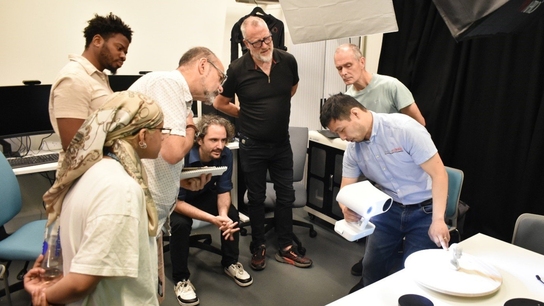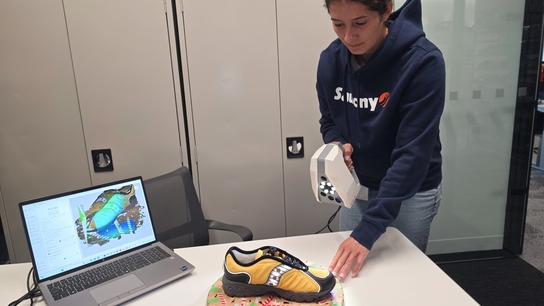Une équipe de chercheurs de Cambridge décode une ancienne collaboration grâce à l’Artec Space Spider
Problématique : Les archéologues avaient besoin d’un moyen de reproduire en toute sécurité une grande variété de récipients en céramique récemment mis au jour et de comparer leurs formes.
Solution : Artec Space Spider, Artec Studio
Résultat : Dans le cadre du projet REVERSEACTION, qui vise à étudier les technologies anciennes complexes dans les sociétés sans État, l’équipe a capturé numériquement plus de 100 artefacts sur le terrain et dans les musées colombiens. Les modèles 3D obtenus facilitent la recherche et la conservation à de multiples niveaux, au-delà des musées et des universités, afin de présenter d’étonnants artefacts anciens dans les salles de classe et sur les appareils personnels.
Pourquoi Artec : Dans le cadre du projet REVERSEACTION, les capacités de scan haute résolution et la courbe d’apprentissage douce de l’Artec Space Spider en ont fait un outil idéal pour numériser des artefacts archéologiques avec la plus grande fidélité, en conservant toutes les géométries élaborées.
Se promener dans un musée, que ce soit physiquement ou numériquement, nous incite souvent à réfléchir aux personnes qui ont fabriqué et utilisé les objets archéologiques anciens que nous voyons. Des professionnels dévoués, des scientifiques aux conservateurs en passant par les restaurateurs, consacrent beaucoup de temps à déchiffrer ces objets ; si ce processus nécessitait autrefois des années de travail minutieux, la technologie moderne permet aujourd’hui de franchir un nouveau palier.
L’équipe du projet REVERSEACTION poursuit un objectif similaire : étudier comment des systèmes technologiques complexes ont été maintenus dans des sociétés anciennes dépourvues de pouvoir politique fort. En intégrant les données archéologiques aux études environnementales, à l’anthropologie, à la sociologie, aux études de gestion et à l’artisanat, l’objectif est d’obtenir de nouvelles informations sur l’action collective. Les découvertes archéologiques telles que l’orfèvrerie, les textiles et les céramiques illustrent le fait que les gens collaboraient volontiers à des projets ambitieux. Ce qui nous amène à nous demander comment les sociétés étaient organisées et gouvernées dans le passé.
Des experts de la recherche à l’œuvre
Implanté à l’Université de Cambridge et financé par le Conseil européen de la recherche (CER), le projet rassemble une excellente équipe de chercheurs d’horizons divers, tous profondément engagés dans la mission du projet. Si leurs activités de recherche couvrent un large éventail, la numérisation des artefacts est un aspect crucial à différents stades. Travaillant sur un large éventail d’objets originaires de Colombie, l'équipe s’est rendue sur le terrain pour créer des jumeaux numériques précis des découvertes, y compris des fouilles archéologiques, des collections en cours de traitement sur les sites et des collections de musées, en particulier celles du partenaire principal du projet, le célèbre Musée de l’Or (Museo del Oro) à Bogota.

Catherine Klesner (à gauche) et Agnese Benzonelli (à droite) examinent les profils extraits d’un modèle 3D d’un récipient en céramique. Avec l’aimable autorisation de Rosie Crawford
En tant que chef de file de la recherche mondiale, l’Université de Cambridge soutient ses équipes avec les dernières technologies disponibles. Patrick Thorn & Co., un partenaire certifié Gold d’Artec 3D avec une vaste expérience dans la technologie 3D, est le consultant de l’université depuis des années, présentant des solutions de nouvelle génération et offrant des conseils sur la façon de les exploiter pour améliorer les résultats de la recherche dans divers domaines universitaires.
Artec Space Spider a été la première recommandation de l’expert, conscient de la nécessité d’un appareil capable de restituer les géométries les plus fines de manière non invasive.
Le bon outil pour capturer les artefacts avec précision
Pour comprendre les formes et les fonctions d’objets historiques tels que des bols spécifiques avec des socles petits ou grands, des fuseaux en pierre utilisés pour le filage des textiles et des matrices en pierre avec des sculptures tridimensionnelles, les chercheurs avaient besoin de documenter chaque bord et chaque rebord. Space Spider s’est avéré idéal grâce à sa grande précision (jusqu’à 0,05 mm) et à sa capacité à capturer des détails et des géométries complexes avec une grande précision.
Pourquoi une telle précision est-elle importante ? Les réponses se trouvent dans les détails : en créant des modèles 3D ultra-détaillés des récipients en céramique, des variations subtiles dans l’épaisseur, la courbure et la forme générale des parois ont été révélées. Celles-ci témoignent de l’existence de techniques sophistiquées dans les sociétés sans État et nous permettent de découvrir des caractéristiques subtiles de la fabrication des récipients.

Utilisation d’un scanner 3D à lumière structurée Artec Space Spider pour étudier des objets de la collection du Museo del Oro, Bogota. Avec l’aimable autorisation de Rosie Crawford
« Nous avons optimisé notre temps de travail sur le terrain en scannant de nombreux objets et en les traitant plus tard, explique Kate Klesner, associée de recherche postdoctorale à l’Université de Cambridge. Ainsi, nous avons documenté plus de 100 objets en céramique, de nombreuses fusaïoles et huit matrices en pierre. »
Les outils utilisés sur le terrain, un XRF portable et un scanner 3D portatif, ont été cruciaux car ils ont permis une analyse non destructive d’objets entiers, fournissant ainsi des données qui n’auraient pas été disponibles à partir de matériaux fragmentaires ou échantillonnés de manière destructive. En outre, des microscopes et des appareils photo numériques portables ont facilité la documentation et l’analyse.
« C’était ma première expérience avec le scan 3D, j’apprenais à scanner ces types d’objets, ce qui s’est avéré assez compliqué à certains égards. Par exemple, lors du scan de ces bols et de ces tasses ouverts, notre plus grande difficulté a été de capturer le bord », ajoute Mme Klesner.
Une confiance à toute épreuve
La capture d’objets archéologiques comporte de nombreux défis, en particulier lorsqu’il s’agit d’artefacts précieux provenant d’un site de fouilles ou d’un environnement muséal.
Mais au fur et à mesure de l’avancement du projet, l’équipe a acquis une plus grande confiance dans la technologie et a été de plus en plus impressionnée par sa rapidité. Pour les récipients en céramique, nous scannions à un rythme d’environ 20 minutes par objet vers la fin, se souvient M. Klesner Cela signifie qu’en l’espace d’une journée, nous pouvions facilement documenter une vingtaine d’objets de manière suffisamment approfondie pour pouvoir les assembler plus tard en toute confiance. »

Catherine Klesner scanne un récipient en céramique de la collection du Museo del Oro, à Bogota, à l’aide d’un scanner 3D à lumière structurée Artec Space Spider. Avec l’aimable autorisation de Rosie Crawford
Prochaine étape : le traitement simplifié
Le traitement des données, effectuée à des étapes ultérieures des projets, principalement à l’Université de Cambridge, s’est avéré un processus agréable. L’équipe a trouvé qu’Artec Studio était facile d’utilisation pour le traitement des scans, la création et l’exportation des modèles. En outre, les chercheurs ont utilisé des logiciels spécialisés tels que Pottery 3D et GigaMesh pour évaluer la forme des récipients à l’aide de la morphométrie géométrique sur des modèles 3D.
Rosie Crawford, assistante de recherche à l’Université de Cambridge, se souvient avoir appris à utiliser le logiciel auprès d’un technicien du laboratoire de paléologie de l’université, où des approches similaires sont adoptées pour les vestiges paléoanthropologiques. Cette formation a été suffisante pour qu’elle puisse ensuite enseigner aux membres de son équipe. « On apprend facilement et on découvre au fur et à mesure ce qui fonctionne le mieux et ce qui ne fonctionne pas », déclare Rosie Crawford.

Rosie Crawford capture une matrice de pierre de la collection du Museo del Oro, à Bogota, à l’aide d’un scanner 3D à lumière structurée Artec Space Spider. Avec l’aimable autorisation de Catherine Klesner
Des données 3D pour mieux comprendre la coopération dans les sociétés sans État
Alors que la plupart des études archéologiques sur la coopération se consacrent à la dynamique sociale au sein de structures hiérarchiques ou à la formation d’États où le pouvoir coercitif était présent, l’équipe de REVERSEACTION explore la coopération volontaire et les collaborations dans des sociétés dépourvues des structures gouvernementales modernes que nous connaissons aujourd’hui.
Ce qui rend cette recherche vraiment unique, c’est le développement de comparaisons entre les matériaux et l’étude de l’acquisition et du transfert des compétences pour tester les hypothèses sur l’interaction artisanale et les méthodes de production durables dans le temps.
Même si des explications sont toujours nécessaires, les modèles obtenus permettent de rassembler des informations sur les techniques de fabrication (du moulage à la cuisson en passant par la décoration de la surface) et sur la durée de vie de différents objets, ce qui donne un aperçu des progrès technologiques et des pratiques quotidiennes des personnes qui ont créé et utilisé ces artefacts. Ces progrès comprennent la création de formes uniformes et de motifs complexes, tandis que les pratiques quotidiennes, telles que les utilisations fonctionnelles et rituelles des récipients, laissent entrevoir les efforts de collaboration et le partage des connaissances entre les artisans, révélant ainsi les structures sociales et économiques qui ont favorisé l’innovation et la résilience dans ces anciennes communautés.
En poursuivant ses recherches sur les technologies céramiques et les interactions entre artisans, l’équipe entend approfondir sa compréhension des traditions techniques, de l’organisation de l’artisanat, des mécanismes de transmission des connaissances et de l’étendue de l’interaction collaborative dans les sociétés sans État.
Révéler les couches : le scan 3D pour un apprentissage accessible
Le fait de disposer de scans 3D des objets a permis à l’équipe de poursuivre ses recherches, et ainsi d’explorer différentes possibilités Pour les céramiques, il ne s’agit que de la première étape d’un processus plus long.
« Nous utilisons les scans 3D et leurs données pour effectuer une analyse morphométrique géométrique, ce qui implique une modélisation informatique pour évaluer la forme, explique Mme Crawford. Nous examinons les variations au sein d’un même récipient et entre différents récipients, ce qui pourrait indiquer des niveaux de compétence différents ou l’intervention de plusieurs artisans, d’autant plus que ces céramiques se trouvent dans des sépultures de la région. Ce processus est essentiel pour la poursuite de nos recherches.
La technologie de scan 3D est cruciale pour comprendre comment ces objets ont été fabriqués et utilisés tout au long de leur vie, ajoute Mme Klesner. Pour la céramique, par exemple, elle nous a permis contre toute attente d’étudier les différentes couches décoratives, ce qui a ajouté une dimension précieuse à notre projet. Par ailleurs, notre étude des matrices de pierre et des fuseaux porte sur leur histoire (comment elles ont été fabriquées, utilisées et déposées) afin de trouver des points communs entre les différentes pratiques artisanales. »

Angela Maria Lucero Bernal (à gauche) et Ana Milena Melo (à droite) étudient des récipients en céramique du projet Union del Sur Rumichaca-Pasto Road à l’aide d’un scanner 3D à lumière structurée Artec Space Spider et d’un microscope numérique portable. Avec l’aimable autorisation de Catherine Klesner
Au-delà de la contribution aux résultats de la recherche, la saisie de données précises sur les artefacts sert un autre objectif important : rendre les objets historiques largement accessibles.
« Beaucoup de ces objets ne sont pas exposés dans des musées ; ils font partie de collections archéologiques qui ne sont pas facilement accessibles à la société dans son ensemble. En rendant ces scans publics et accessibles, les gens pourront voir de leurs propres yeux ces objets complexes et étonnants, » conclut Mme Klessner.
Le projet REVERSACTION, qui vise à modifier l’ancien paradigme en explorant l’action collective volontaire plutôt que les hiérarchies, est véritablement révolutionnaire. Et si la lumière jetée sur ces artefacts anciens et sur la manière dont ils ont été fabriqués révélait également l’idée que la volonté de coopérer est, comme elle l’a toujours été, la clé de la résolution de la plupart des problèmes mondiaux ? Il est alors étonnant de constater qu’une partie de cette lumière est projetée, littéralement, depuis l’Artec Space Spider.
Scanners derrière l'histoire
Essayez les meilleurs scanners 3D au monde.





